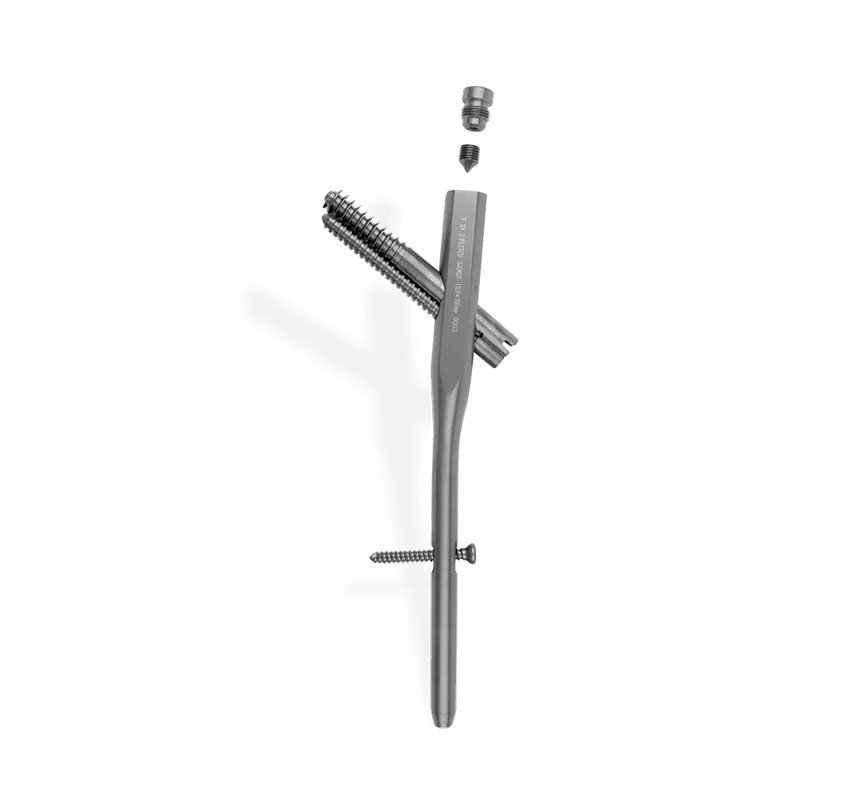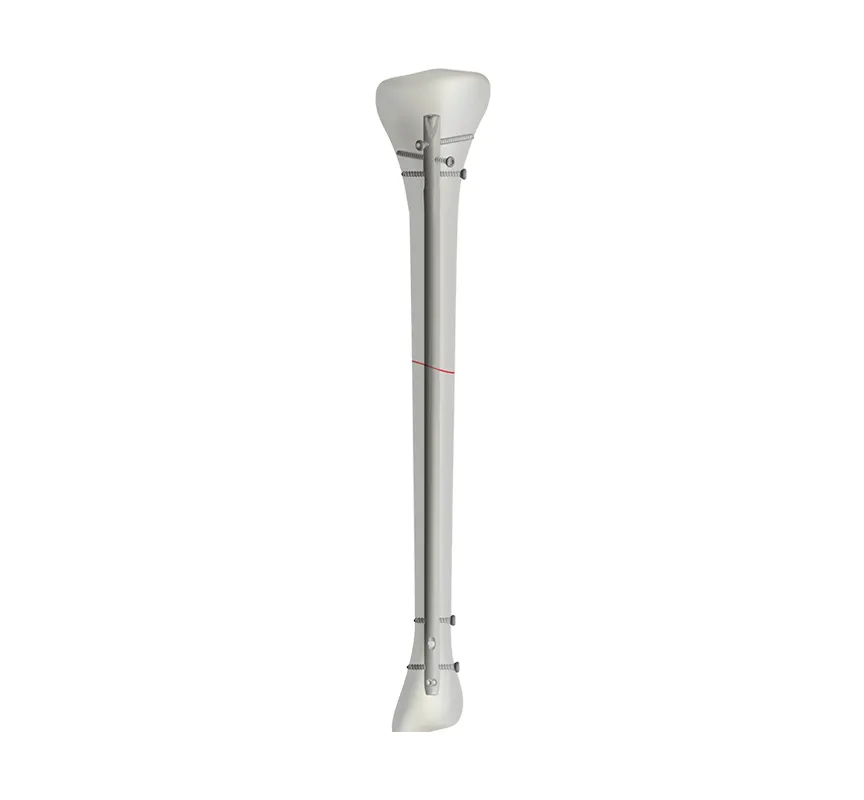Intramedullary nails function as internal splints that are inserted directly into the hollow center of long bones, effectively stabilizing fractures from within. Their primary role is to share the mechanical load across the fracture site, which is crucial for maintaining the overall stability needed throughout the healing process. This load-sharing ability helps to distribute forces evenly along the length of the bone, reducing stress concentration at the fracture and promoting a more natural and efficient healing environment. Unlike traditional fixation methods such as plates, which are applied externally along the surface of the bone, intramedullary nails provide axial support that is perfectly aligned with the bone’s natural load-bearing axis. This alignment ensures that the forces generated during movement and weight-bearing are transmitted through the nail and bone in a manner that mimics physiological conditions, resulting in enhanced stability and improved functional outcomes for patients recovering from long bone fractures.
Modern Approaches to Long Bone Fracture Treatment
Long bone fractures are among the most challenging injuries in orthopedic medicine. Treating these fractures effectively requires reliable, durable, and precise fixation methods to ensure proper healing and restore function. One of the most widely used techniques involves the use of intramedullary nails. These devices have transformed fracture management with their unique design and application benefits.
Intramedullary nails have become a cornerstone in orthopedic surgery, offering patients faster recovery times and improved outcomes. But what exactly makes intramedullary nails stand out? This article explores the key advantages of intramedullary nails in long bone fracture treatment, focusing on their design, functionality, and clinical benefits.
Advantages of Intramedullary Nails in Fracture Stabilization
Minimally Invasive Surgical Technique
Intramedullary nails allow for a less invasive surgical approach compared to traditional fixation methods. Because these nails are inserted into the marrow canal of long bones, surgeons can avoid large incisions and extensive soft tissue disruption. This minimally invasive approach results in reduced blood loss, less postoperative pain, and lower infection risk.
The minimally invasive approach associated with intramedullary nails significantly contributes to faster patient mobilization and recovery. Because the procedure requires smaller incisions and less disruption of surrounding tissues compared to traditional methods, patients often benefit from reduced postoperative pain and swelling. This facilitates quicker return to daily activities and promotes earlier functional recovery, which is essential in preventing common complications like deep vein thrombosis or muscle atrophy. Such benefits are particularly vital for elderly patients or those with existing health conditions, where minimizing surgical trauma and preserving overall physiological function can greatly impact the outcome. By reducing the surgical footprint, intramedullary nails help ensure a smoother and safer healing process for these vulnerable populations.
Load Sharing and Mechanical Strength
This structural advantage enables patients to begin weight-bearing and mobilization much earlier than with other fixation methods, which significantly contributes to improved overall bone healing. By allowing early movement, intramedullary nails help to stimulate biological processes essential for bone regeneration and recovery. Additionally, the inherent mechanical strength of intramedullary nails decreases the likelihood of implant failure, providing a reliable and durable support system during the entire recovery period. This robustness is especially important in managing complex fractures or fractures situated in major weight-bearing bones like the femur or tibia, where maintaining proper alignment and stability is critical. As a result, intramedullary nails offer a dependable solution that supports both structural integrity and functional restoration in these challenging clinical scenarios.
Design Features Enhancing the Effectiveness of Intramedullary Nails
Anatomical Compatibility and Customization
Contemporary intramedullary nails are meticulously engineered to align with the anatomical characteristics of long bones. These implants come in a range of shapes and sizes tailored to match the natural curvature and dimensions of bones such as the femur, tibia, and humerus. This precise anatomical fit not only improves the overall stability and fixation of the fracture site but also significantly reduces the likelihood of soft tissue irritation or impingement around the implant. By closely mirroring the bone’s natural form, modern intramedullary nails provide a more comfortable and effective solution for fracture treatment, enhancing patient outcomes and promoting smoother recovery.
Customization options for intramedullary nails also include advanced locking mechanisms designed to enhance stability. Multiple locking screws can be strategically placed at both ends of the nail, ensuring a secure fixation within the bone. This configuration plays a crucial role in controlling rotational stability, preventing unwanted twisting movements that could disrupt the healing process. Additionally, it restricts axial movement along the length of the bone, maintaining proper alignment throughout recovery. These locking features are essential for promoting effective bone healing, particularly in fractures that require precise immobilization to heal correctly.
Materials and Biocompatibility
Intramedullary nails are commonly made from titanium or stainless steel alloys known for their strength and biocompatibility. Titanium nails, in particular, offer advantages such as lower weight and better corrosion resistance. Their biocompatible properties reduce the risk of allergic reactions and facilitate better integration with the surrounding bone tissue.
Material choice plays a significant role in the long-term success of intramedullary nails, ensuring durability without compromising patient safety. Advanced manufacturing techniques have also improved the surface finish of these implants, enhancing their fatigue resistance and reducing the likelihood of implant-related complications.

Clinical Benefits and Patient Outcomes with Intramedullary Nails
Faster Healing and Reduced Complications
Clinical studies have demonstrated that intramedullary nails significantly contribute to faster fracture healing when compared to certain alternative fixation techniques. Their unique ability to maintain mechanical stability while facilitating effective load sharing creates an optimal environment for physiological bone remodeling. This stability not only protects the fracture site but also encourages robust callus formation, which is a critical step in the natural healing process. By supporting these biological mechanisms, intramedullary nails help accelerate recovery times and improve overall outcomes for patients with long bone fractures.
The use of intramedullary nails involves less surgical trauma compared to more invasive procedures, which significantly reduces the risk of infection and other complications after surgery. Because the procedure is minimally invasive, patients experience less tissue damage and a lower likelihood of postoperative issues. Moreover, the design of intramedullary nails supports early mobilization, allowing patients to begin moving sooner. This early movement is crucial for preserving muscle strength and maintaining joint function, both of which play important roles in facilitating a smoother and more effective rehabilitation process. Together, these factors contribute to improved patient outcomes and faster recovery times.
Versatility in Treating Various Fracture Types
Intramedullary nails are suitable for a wide range of long bone fractures, including simple transverse fractures, comminuted fractures, and even some open fractures. Their versatility allows orthopedic surgeons to address different injury patterns with a single implant system.
This adaptability reduces the need for multiple surgical interventions and simplifies inventory management for healthcare facilities. It also means patients can receive tailored treatment plans that address their specific fracture characteristics efficiently.
Surgical Considerations and Future Directions
Preoperative Planning and Imaging
Successful use of intramedullary nails depends heavily on thorough preoperative planning. Detailed imaging techniques such as X-rays and CT scans allow surgeons to assess fracture type, bone geometry, and any anatomical challenges. This information is critical in selecting the correct nail size and locking configuration.
Accurate preoperative assessment helps minimize intraoperative complications and optimizes implant positioning. Advances in surgical navigation and computer-assisted technologies are further enhancing the precision of intramedullary nail placement.
Innovations in Intramedullary Nail Technology
Ongoing research and development continue to improve intramedullary nails. Innovations include nails with enhanced locking systems, bioactive coatings that promote bone growth, and designs tailored for specific patient populations such as pediatric or osteoporotic patients.
These advancements aim to reduce healing times, improve implant longevity, and expand the applications of intramedullary nails in orthopedic trauma care. The future of fracture management will likely see even more personalized and efficient intramedullary nail solutions.
Frequently Asked Questions
What are intramedullary nails used for?
Intramedullary nails are used to stabilize long bone fractures by being inserted into the bone’s marrow canal. They provide internal support, allowing the bone to heal properly while maintaining alignment.
Are intramedullary nails suitable for all types of long bone fractures?
While intramedullary nails are versatile, their suitability depends on the fracture type and location. They are most effective in diaphyseal fractures of long bones like the femur, tibia, and humerus.
How long does it take to recover after intramedullary nail surgery?
Recovery times vary based on fracture severity and patient health. Generally, patients can start weight-bearing earlier compared to other fixation methods, with full recovery often occurring within several months.
Can intramedullary nails cause complications?
As with any surgical implant, there are risks such as infection, implant failure, or irritation. However, intramedullary nails have a good safety profile when used appropriately, and complications are relatively uncommon.
Table of Contents
- Modern Approaches to Long Bone Fracture Treatment
- Advantages of Intramedullary Nails in Fracture Stabilization
- Design Features Enhancing the Effectiveness of Intramedullary Nails
- Clinical Benefits and Patient Outcomes with Intramedullary Nails
- Surgical Considerations and Future Directions
- Frequently Asked Questions
 EN
EN
 FR
FR
 ES
ES
 AR
AR

